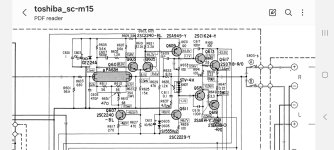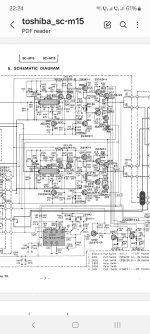Hi, I own an old Toshiba aurex sc-m15 amplifier. If i listen on low volume after some time one channel starts to change its volume ( sounds even lower volume ) if i increase the input signal it's going back to normal, changing it to lower volume after a while the same happens. [ (This is only the amp, fed from my dac) without the pre amp
aurex sy-c15 that works fine on its own. ]
Maybe some capacitors , I have no ideea what would cause this. A full re cap would be needed since it's very old, but I'm not sure if it's worth repairing. The case ( big aluminium case ) and the transformer could be used to build something different in it.
- Bruno.
aurex sy-c15 that works fine on its own. ]
Maybe some capacitors , I have no ideea what would cause this. A full re cap would be needed since it's very old, but I'm not sure if it's worth repairing. The case ( big aluminium case ) and the transformer could be used to build something different in it.
- Bruno.
Attachments
yes - speaker DC protect relay contacts S803/804 (protect-IC: TA7317)
for replacement hints go to #36-38 under
P.S.: under
https://ameblo.jp/audio-sin/entry-11955118930.html
https://ameblo.jp/audio-sin/image-11955118930-13135757403.html
good internal pictures
and under
https://www.audiovintage.fr/leforum/viewtopic.php?t=28492
good outside pictures of this power amp model
for replacement hints go to #36-38 under
as above. I am thinking amps but could voltage rating x amps? Thanks again
- mrjayviper
- Replies: 57
- Forum: Parts
P.S.: under
https://ameblo.jp/audio-sin/entry-11955118930.html
https://ameblo.jp/audio-sin/image-11955118930-13135757403.html
good internal pictures
and under
https://www.audiovintage.fr/leforum/viewtopic.php?t=28492
good outside pictures of this power amp model
Last edited:
Damn, it didn't cross my mind the relays might be the cause. Thank you!.
I will take it apart and see what relays they use and clean them or change them .
I will take it apart and see what relays they use and clean them or change them .
Contacts are normally open ,I applied 24vdc with them out of the board , they measure 0.1 ohm ( very little current with the multimeter ) I doubt they are faulty.
Thought, the contacts look " bad "
Could something else be the problem ? .
Or still the relais . Even if they measure fine.
Thought, the contacts look " bad "
Could something else be the problem ? .
Or still the relais . Even if they measure fine.
Attachments
-
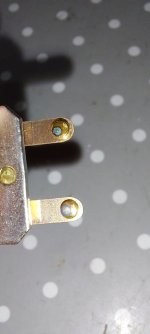 Screenshot_20241122_145319_Gallery.jpg178.5 KB · Views: 49
Screenshot_20241122_145319_Gallery.jpg178.5 KB · Views: 49 -
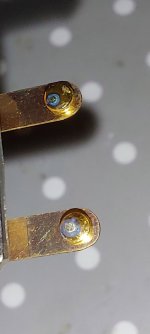 Screenshot_20241122_145327_Gallery.jpg135.3 KB · Views: 46
Screenshot_20241122_145327_Gallery.jpg135.3 KB · Views: 46 -
 Screenshot_20241122_145331_Gallery.jpg136.4 KB · Views: 47
Screenshot_20241122_145331_Gallery.jpg136.4 KB · Views: 47 -
 Screenshot_20241122_145341_Gallery.jpg263.2 KB · Views: 47
Screenshot_20241122_145341_Gallery.jpg263.2 KB · Views: 47 -
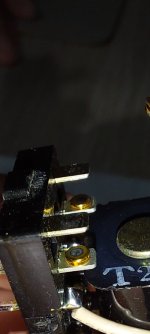 Screenshot_20241122_145347_Gallery.jpg188.1 KB · Views: 51
Screenshot_20241122_145347_Gallery.jpg188.1 KB · Views: 51 -
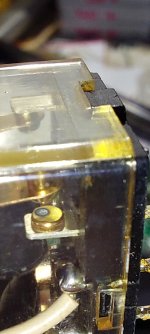 Screenshot_20241122_145354_Gallery.jpg229.7 KB · Views: 42
Screenshot_20241122_145354_Gallery.jpg229.7 KB · Views: 42 -
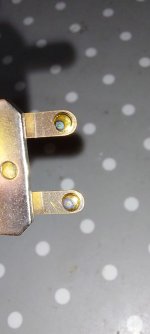 Screenshot_20241122_145314_Gallery.jpg181.4 KB · Views: 47
Screenshot_20241122_145314_Gallery.jpg181.4 KB · Views: 47
If possible, replace them. Cleaning them only scrapes off the tiny layer of gold or silver, and that is already gone, looking at the pictures.I will take it apart and see what relays they use and clean them or change them .
around 10mVWith the amp powered can you measure any DC on the outputs?
I applied 24vdc
The contacts should look golden all over.
These look like they need to be replaced.
If you apply 24Vdc, this is a high voltage compared to the output at low volume, no wonder...
24Vdc to the relay coil only !. Contacts measured with multimeter on resistance , so very little current trough them , measured 0.1ohm .I applied 24vdc with them out of the board , they measure 0.1 ohm ( very little current with the multimeter )
I will replace them anyway , regardless if they are still good or not. The contacts look bad indeed ! tho they measure fine ( on low current trough them , I understand higher current would " make it trough " oxidation , etc. ) . that's why I wonder if there's something else faulty.
Could also be a cold solder joint theoretically...
...or the speaker switches, they are in series with the relay...
...or the btl switch.
...or the speaker switches, they are in series with the relay...
...or the btl switch.
Those are goners. Replace for fully sealed relays with bifurcated contacts of a silver alloy. By a good known good quality brand and preferably of some years ago. Todays relays by chinese brands or chinese production can be quite bad.
This is the japanese disease: choosing gold or gold plated contact relays to switch current. Plain wrong!
Gold (plated) = voltage/signal
Silver (and alloys) = current
Measuring the contacts is quite hard. Very often the measurements tell all is good but they fail in real use. In severe cases they can behave like semiconductors causing nasty distortions.
Tip: it helps to have volume at 0 when switching on the amplifier.
This is the japanese disease: choosing gold or gold plated contact relays to switch current. Plain wrong!
Gold (plated) = voltage/signal
Silver (and alloys) = current
Measuring the contacts is quite hard. Very often the measurements tell all is good but they fail in real use. In severe cases they can behave like semiconductors causing nasty distortions.
Tip: it helps to have volume at 0 when switching on the amplifier.
Last edited:
Measuring the contacts is quite hard. Very often the measurements tell all is good but they fail in real use. In severe cases they can behave like semiconductors causing nasty distortions.
Tip: it helps to have volume at 0 when switching on the amplifier.
Multimeter ohms range is 0.7V dc, music is ac, there are always zero crossings.
Especially switching off under load is a bad idea because the voice coils are inductive.
I know. Should have been:
Tip: it helps to have volume at 0 when switching the amplifier either on or off.
When these problems occur and the loudspeakers relays have gold (plated) contacts… don’t measure/assume/theorize or do the stupid habit to sand the contacts. Just replace for a relay that should have been used. In japanese hifi from the seventies to the nineties almost always the wrong relays were chosen for this particular purpose. Regardless of brand reputation or famous designer (insert famous name here). Simple but true.
Oh and do put time in finding a fully sealed silver (alloy) contacts relay with higher current rating with a minimum of 8A.
Tip: it helps to have volume at 0 when switching the amplifier either on or off.
When these problems occur and the loudspeakers relays have gold (plated) contacts… don’t measure/assume/theorize or do the stupid habit to sand the contacts. Just replace for a relay that should have been used. In japanese hifi from the seventies to the nineties almost always the wrong relays were chosen for this particular purpose. Regardless of brand reputation or famous designer (insert famous name here). Simple but true.
Oh and do put time in finding a fully sealed silver (alloy) contacts relay with higher current rating with a minimum of 8A.
Last edited:
This is an important step to avoid a deterioration in sonic performance after a short time.Those are goners. Replace for fully sealed relays with bifurcated contacts of a silver alloy. By a good known good quality brand and preferably of some years ago. Todays relays by chinese brands or chinese production can be quite bad.
This is the japanese disease: choosing gold or gold plated contact relays to switch current. Plain wrong!
Gold (plated) = voltage/signal
Silver (and alloys) = current
Measuring the contacts is quite hard. Very often the measurements tell all is good but they fail in real use. In severe cases they can behave like semiconductors causing nasty distortions.
Tip: it helps to have volume at 0 when switching on the amplifier.
I have purchase several vintage SDS Relays as NOS of those from first attachment in post #37 under
as above. I am thinking amps but could voltage rating x amps? Thanks again
- mrjayviper
- Replies: 57
- Forum: Parts
The disadvantage is that one have to wire it freely with silver wire because of the different PIN outline, but I accept that.
There are many that work fine. Those with tungsten contacts bridged by silver contacts are nice but either expensive or hard to find. There are countless silver contact relays that also will have a long service life and practically no negative impact on sound quality. I would never use MOSFET solutions and electronic semi based stuff as their sonical impact may overshadow their purpose. Maybe nice for digital trickery if you are into that.
It is of course best to use a physically compatible type (generally found in abundance) without the need for extra wiring.
It is of course best to use a physically compatible type (generally found in abundance) without the need for extra wiring.
Last edited:
- Home
- Amplifiers
- Solid State
- Toshiba Amplifier turns volume down on it's own
